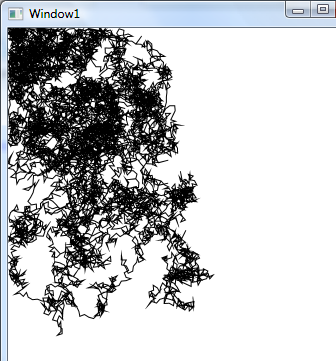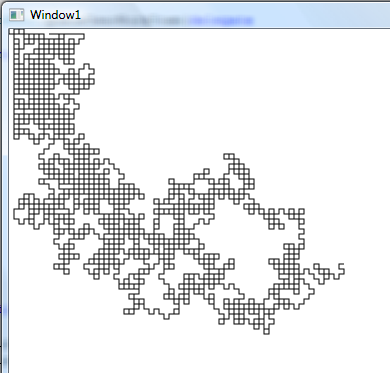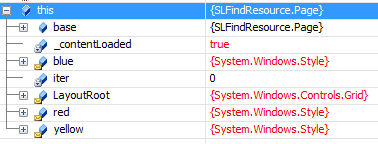Microsoft DPE: "WPF is ever best super performance oriented technology for creating hyper multi point graphs, using parallelism and huge in-memory persistence vector scrounged math distributed calculations... And ever more with branded new Microsoft Windows Vista 7.
Client: Errr, well.... Let's try to apply it for our VB program...
DPE: You can easily do it yourself, but it'd be better to call someone from Microsoft Consulting Services.
Client: Let it be...
MCS: Well. It's too huge for WPF to scale... WPF uses a retained rendering system. It saves every little pixel and make you able scale and repaint very often without the composition system blocking on callbacks to your code. However, 1,000,000 retained pixels is too huge to scale...
Client: I want it scale. They promised... They told, it'll scale. Make it to do what I want it to do!!!
MCS: Errr, well. Let it be!
This is very common dialog between DPE, MCS and clients. Sales men want it to do, what he need it to do. Client want it to do what sales men promised to do and Services men should make it to do what they both want it to do. Today we'll speak about retained, lazy and loose models to produce large scale graphics.
First problem: multithreading
Even before we start to work, you should know, that we cannot create dependency objects in thread other, then current UI thread. We can use locks, mutexes, semaphores, however we still can not create Dependency Objects in other thread. In order to get rid of it, we'll have to use INofityPropertyChanged implementation, instead of Dependency Objects. This means, no Dependency Properties.
So, we'll start with following code (I'll reuse nice code written by Luis Diego Fallas to create Mandelbrot Fractal set)
class FractsCollection : INotifyPropertyChanged
{
Second problem: rendering thread
Well, the problem is knows. There is only one UI thread. We wont it be only one, so we'll use our own HostVisual by Dwayne Need to enhance the performance.
Third problem: Retained objects
Actually, this is not problem. This is feature. And it can be extremely useful if you want to retain layout. Let's create a simple example: Dragon curve fractal. It has limited number of points, generated by well known final algorithm. So, we'll create our own geometry, derived from Shape class. The fasted geometry is StreamGeometry, so let's use it. First of all let's create the class and save the array of points.
public class DragonShape:Shape
{
StreamGeometry dragonGeometry;
double _angle;
List<Point> Points;
Then we'll generate the pattern
void GeneratePattern()
{
ThreadPool.QueueUserWorkItem(delegate
{
Move(5);
Turn(GetNextPoint * System.Math.PI / 180.0);
Then, by overriding DefiningGeometry property, create the fractal
protected override System.Windows.Media.Geometry DefiningGeometry
{
get {
using (StreamGeometryContext context = dragonGeometry.Open())
{
context.BeginFigure(Points[0], false, false);
context.PolyLineTo(Points, true, false);
}
return (Geometry)dragonGeometry.GetAsFrozen();}
}
Don't forget to tell the shape, that geometry was changed
this.Dispatcher.BeginInvoke(System.Windows.Threading.DispatcherPriority.Background, (SendOrPostCallback)delegate
{
this.InvalidateVisual();
}, null);
Now, run it and we'll have very nice vector fractal generated that can be easily resized and scaled. Here the result.


This method will work fine for 1,000, even 10,000 points. But after a while you'll experience performance degradation. What to do? The client wants 10,000,000 (!) points (and in Winforms GDI+ it works for him)
Let's try to understand why. Because it is not retain. It's image! So, let's use image to make the play fair.
The fastest BitmapSource is InteropBitmap. It has an ability to update itself from the memory section. That's exactly what we'll use
format = PixelFormats.Bgr32;
max = format.BitsPerPixel;
uint count = (uint)(sWidth * sHeight * format.BitsPerPixel / 8);
section = CreateFileMapping(new IntPtr(-1), IntPtr.Zero, 0x04, 0, count, null);
map = MapViewOfFile(section, 0xF001F, 0, 0, count);
pixels = new byte[count];
Marshal.Copy(pixels, 0, map, (int)count);
source = System.Windows.Interop.Imaging.CreateBitmapSourceFromMemorySection(section, (int)sWidth, (int)sHeight, format, (int)(sWidth * format.BitsPerPixel / 8), 0) as InteropBitmap;
ThreadPool.QueueUserWorkItem(delegate
{
while (true)
{
Generate();
}
});
To get the source to bind to we'll get frozen image. Call Invalidate first to reread the source.
InteropBitmap source;
public BitmapSource Source
{
get
{
source.Invalidate();
return (BitmapSource)source.GetAsFrozen();
}
}
Now, when we ready to display we can just put pixels simultaneously (by using Parallel extension and PLINQ) and tell the WPF that our count and ImageSource property updated upon each pixel.
unsafe
{
uint* pBuffer = (uint*)map;
Parallel.For(0, (int)sHeight, delegate(int yi)
{
foreach (var p in from xi in Enumerable.Range(0, (int)sWidth).AsParallel()
let mappedX = xF(xi)
let mappedY = yF(yi)
let p0 = new TranslatePoint(xF(xi), yF(yi))
let function = constructor(p0)
select new
{
x = xi,
y = yi,
xD = mappedX,
yD = mappedY,
i = apply(function, p0)
.TakeWhile(
(x, j) => j < max && x.NormSquared() < 4.0)
.Count()
})
{
pBuffer[(int)(p.x + p.y * sWidth)] = (uint)(uint)((uint)0xFF << 24) |
(uint)(p.i << 16) |
(uint)(5*p.i << 8) |
(uint)(15*p.i); ;
count++;
FireUpdate();
}
});
}
void FireUpdate()
{
if (PropertyChanged != null)
{
PropertyChanged(this, new PropertyChangedEventArgs("PixelCount"));
PropertyChanged(this, new PropertyChangedEventArgs("Source"));
}
}
We done. Now let's see how fast it can be to generate and display 10,000,000 live pixels (it's about 16,000x16,00x32bit image) in screen. The maximum, I was able to get with my Dell Latitude D820 was 1,200,000 x 1,200,000 pixels indexed 4 bit image (it's about 100,000,000 points) and my memory is over :)
Not bad, ah? So WPF scales and DPE are right? Not quite right, but let them to do their work and we'll be behind to come all client's dreams (and DPE's promises) true.
Have a nice day and be good people. Now you can use WPF for drawing big number of points.




